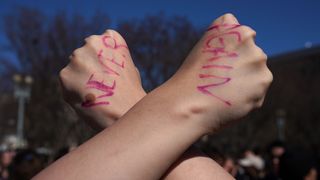The kids are all right. That’s the takeaway from the last several weeks in the US, where teenagers have been leading a new gun-control movement that seems to have some staying power — an unexpected development in a nation where the combination of frequent massacres and congressional inaction have led to a sort of numb nihilism.
That the students who survived the Parkland massacre have emerged as leaders of a political movement comes as a surprise. After all, most are younger than 18, the national voting age. But they have seized the reins of political activism, driving a powerful new movement on gun control. And the power of their activism has some people wondering if voting rights should be extended to people younger than 18.
The #NeverAgain movement of the Parkland survivors has been surprisingly long-lived. That may be an odd claim, given that the massacre was less than a month ago. But the news cycle around mass shootings in America rarely extends longer than a week. There are a few days spent on the shock of the shooting, a few on the shooter, a day or two on public outrage over congressional inaction, and then the country moves on.
Something different has happened post-Parkland, though. Media coverage has been sustained, focusing far more on the young students and the effects of their activism. Corporations have started severing their ties with the National Rifle Association, the powerful gun lobby that controls the debate over weapons laws in the US, and politicians have faced immense public pressure to advance legislation that would limit access to semi-automatic weapons.
Something different has happened post-Parkland, though. Media coverage has been sustained, focusing far more on the young students and the effects of their activism.
That sustained media attention has been driven by the students themselves. Digital natives, they have been profoundly effective on social media, where the students have become must-follows for anyone in journalism (Parkland student Emma Gonzalez quickly amassed 1.8 million followers, more than the NRA).
Their sharp, incisive critiques, as well as their quick-witted verbal sparring, have driven debate and coverage. Tweeting about Marco Rubio, the Republican senator who takes significant donations from the NRA and refuses to move on gun control, student Sarah Chadwick tweeted: “We should change the names of AR-15s to ‘Marco Rubio’ because they are so easy to buy.”
These students have combined their effective hashtag activism with more traditional forms. Students participated in a CNN town hall debate with Senator Rubio, have appeared on nearly every type of television and radio show, and are organising a nationwide march that will take place later this month. That march will ensure their cause continues to receive media attention in the weeks and month ahead.
It's a smart strategy. Sustained media attention has both highlighted and expanded support for gun control measures. More than nine in 10 Americans support mandatory background checks for gun purchases. More than eight in 10 agree that the age limit for buying a gun should be raised from 18 to 21. And a full 72 per cent believe assault-style weapons should be banned — including 58 per cent of Republicans.
The disconnect between public opinion and congressional inaction is creating intense pressure in Congress. And while it’s difficult to imagine a Republican-controlled Congress moving on guns, it is fairly easy to imagine an enraged electorate replacing those Republicans with Democrats.
All of this has some Americans wondering if laws other than those pertaining to guns should change. Perhaps the voting age should drop as well, so these teenagers, especially the 16- and 17-year-olds, have a say in the laws that control their lives.
There is a precedent for this. In the early 1970s, the national voting age dropped to 18 from 21. It did so because of the jarring disconnect between the age Americans could be drafted and the age they could vote. In the midst of the Vietnam War, it seemed intolerable that 18-year-olds could be forced to serve in a war long before they could cast a vote for their leaders. So in 1971, Congress passed, and the states ratified, the 26th Amendment, lowering the voting age.
In America today, teenagers are back on the front lines, though now in their classrooms rather than in foreign lands. That they should have a say in the government that keeps them on the front lines is a compelling argument — though as we saw in Sandy Hook, even kindergartners are drafted into this war.
In America today, teenagers are back on the front lines, though now in their classrooms rather than in foreign lands. That they should have a say in the government that keeps them on the front lines is a compelling argument — though as we saw in Sandy Hook, even kindergartners are drafted into this war.
It’s unlikely 16 and 17-year-olds will get the vote nationwide. It would require a constitutional amendment, which requires bipartisan support, and currently Republicans oppose any expansion of the franchise. In fact, they’ve spent the last decade actively working to narrow it, which suggests something about the breadth of their party’s appeal and their commitment to representative democracy.
So a constitutional amendment is likely to be off the table, at least for now. But states and localities have started experimenting with lower voting ages, allowing 16 and 17-year-olds to vote in local elections. If more and more do, the young people of America will likely have the Parkland students to thank.
And if gun laws do change in the coming years, the Parkland activists deserve a good deal of the credit. Drafted into a war they did not want to fight, they’re proving to be adept warriors.






